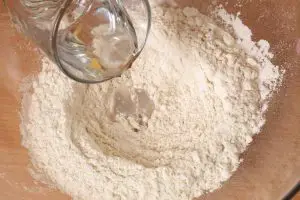Making homemade bread is a lot of fun, but you have to have the right ingredients for it to come out right. One of the most important bread-making ingredients is the oil, and believe it or not, not just any oil will do most of the time.
To determine what the best oil is for your homemade bread, we have to first take a look at why we put oils in the bread in the first place. The type of oil that you use in bread also depends on the type of bread you’re making, but it’s a lot easier to understand all of this than you think.
Why Does Bread Dough Need Oil?
First of all, when you’re following a bread recipe, you have to follow it to the letter. That’s the thing about making bread from scratch; with just one step messed up or forgotten altogether, you can usually forget about having fluffy, chewy bread in the end.
When you add fat such as oil to your bread dough, it acts as a tenderizer and coats some of the proteins that form gluten. This, in turn, prevents those proteins from becoming too moist and therefore forming large “globs” of wetness that could possibly lead to the bread being too tough.
Yet another thing to remember is that regardless of how much or little oil the recipe asks for, that particular amount is important. It’s easy to understand why breads that require a lot of oil need that much oil. For instance, dinner rolls simply wouldn’t be fluffy and tasty without the oil included in the recipe.
But make no mistake about it. The breads that only need small amounts of oil still need that oil for them to taste right when they’re finished baking. This is why following the directions in the recipe exactly as they are printed is so crucial.
Finally, adding oil to bread dough does three additional things:
- It helps create a longer shelf life for the bread
- It helps bind all of the ingredients together a lot better
- It helps make loaf breads a lot easier to slice after they’re baked
There are other reasons, too, including that oil adds flavor to bread and helps create better elasticity. We could go on and on, but the bottom line is this: most breads need oil to taste like they should and have the perfect texture.
French bread, for example, is usually made without oil, and while it’s still delicious, there is a definite difference in the texture of French bread compared to the texture of most other types of bread. These things are all proof of how important oil — and the exact amount of oil required — is to the recipe and the final result.
The Best Oils for Making Bread
If you’ve ever been curious about the best oil for breadmaking and the recipe calls for a particular type, it’s best to use that type. Having said this, as long as the recipe calls for a “neutral-tasting” oil, you can certainly substitute that for another neutral oil.
This is because one of the many reasons for adding oil to a bread recipe is to give the bread a certain taste. If your bread is supposed to have an olive oil flavor, you can’t use vegetable oil in place of olive oil without giving the bread a completely different flavor.
There are lots of oils you can use for your homemade bread, but the following three oils tend to get tons of “thumbs up” from a lot of bread-making enthusiasts.
1. Margarine or Butter
Solid fats such as margarine or butter add flavor to bread and soften the texture as well. If you’re baking any type of sweet bread, it will likely list either margarine or butter as an ingredient in the recipe. If a recipe calls for margarine or butter, two things should be kept in mind. First of all, always use softened margarine or butter but never use these fats in liquid or melted form. Let the margarine or butter soften, then cut it into small chunks before adding it to your recipe.
The second tip when using butter or margarine in your bread recipe is to never, ever use any type of low-fat or reduced-fat product in place of the real thing. This is bread, after all, and the reason why the recipe calls for margarine or butter is because it needs fat to do its thing. So, use real margarine or real butter and nothing that is low-fat, no-fat, low-salt, etc.
2. Olive Oil
Last update on 2025-06-15 / Affiliate links / Images from Amazon Product Advertising API
If a recipe calls for either olive oil or vegetable oil, you can use any type of olive oil in its place. Olive oil is extremely good for you and a lot of baking enthusiasts say that once you start using olive oil to make your homemade bread, you’ll never go back to using anything else. Nevertheless, it’s good to remember that virgin and extra-virgin olive oil, while healthier, are also a lot stronger in taste and this could change the flavor of the bread.
We mention this because if you’re making a sweet bread or a bread that is delicately flavored, olive oil might not be a good option for you because it can make the bread taste a little too strong. When using olive oil, you’ll have to use a little common sense and keep in mind the flavor that you want the bread to have in the end.
3. Vegetable Oil
Vegetable oil is a good general-use oil that always seems to work well when making bread. Because of this, if the recipe calls for vegetable oil and you don’t have any in your kitchen, you can use other oils in its place, including canola, corn, and peanut oil.
In most cases, it’s best not to use any flavored oils unless you want the flavor of the bread to be altered. Using vegetable, canola, corn, and peanut oil interchangeably is acceptable, but make sure that the oil is the plain type and isn’t flavored with some fancy taste.
Can You Use Other Types of Oil?
There are numerous other types of oil that can be used in breads, including sesame oil, walnut oil, and garlic oil. These each have unique flavors and make it fun to experiment with different breads to see how they taste in the end. If your bread recipe calls for vegetable oil and you’d like to add a little oomph and extra flavor to it, you can use one of these oils instead and see where it takes you.
Indeed, if your recipe offers you options when it comes to the type of oil that you can use and you’re trying to choose the healthiest oils possible, just remember that vegetable, canola, and olive oil are some of the healthiest oils on the planet
Another one, avocado oil, is also heart-healthy and can often be used in place of other types of oil. Just remember that it does have a taste like avocados (duh!), and this can affect the way the bread tastes in the end.
How Do I Choose a Healthy Oil for My Bread?
When you have a choice and you’re not sure which oil to pick, it’s best to choose an oil that has a high smoke point. The smoke point is the temperature that an oil has to be before it starts to smoke, which makes it taste very bitter or gives it a “burnt” flavor. If you cook or bake with an oil that has a low smoke point, the molecular structure of the fatty acids can be affected, and it can even start to produce free radicals, which are often harmful.
Here are some smoke points of some of the most common types of cooking oils:
- Avocado oil: 375 degrees Fahrenheit (high)
- Canola oil: 400 degrees Fahrenheit (high)
- Peanut oil: 450 degrees Fahrenheit (high)
- Pure or light olive oil: 375 degrees Fahrenheit (high)
- Safflower oil: 510 degrees Fahrenheit (high)
- Sesame oil: 350-410 degrees Fahrenheit (high)
- Vegetable oil: 400-450 degrees Fahrenheit (high)
Ideally, if you’re going to use an oil for your homemade bread, these are the oils that you’ll want to use because they have some of the highest smoke points of all cooking oils on the market.
Other Things to Consider
Oil is used in bread to improve its texture, keep it softer longer, increase its shelf life, and a few other things. But what if the recipe doesn’t call for any oil? Some recipes only have four ingredients for their bread: flour, water, salt, and yeast. Is it possible to add oil to these types of recipes even though they don’t call for it? The answer is usually “yes.”
As mentioned earlier, certain breads — French bread comes to mind — need to be made without oil, but for the most part, adding a teaspoon or so of oil to your bread dough can make the bread a little softer and maybe even a little tastier. In short, adding oil to bread dough rarely does it any harm, and if you use margarine or butter, olive oil, or vegetable oil, you really can’t go wrong.

![ZOE Extra Virgin Olive Oil 1L (33.8 fl oz) | Freshly Harvested, First Cold-Pressed | High Polyphenol, Hand-Selected Olives from Spain | Fruity Flavor, Rich Aroma | BPA-Free Tin [Pack of 2]](https://m.media-amazon.com/images/I/51w-jIHKMDL._SL160_.jpg)







